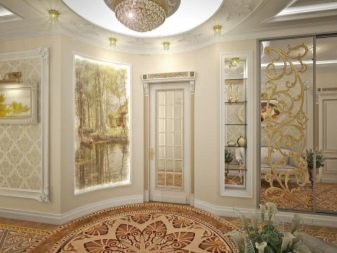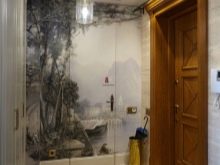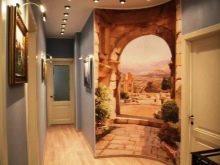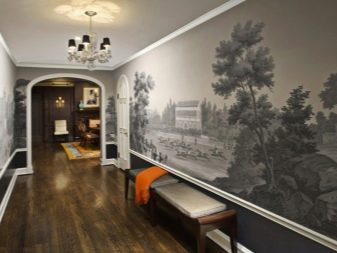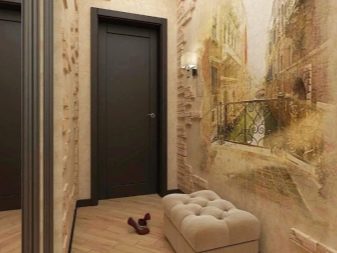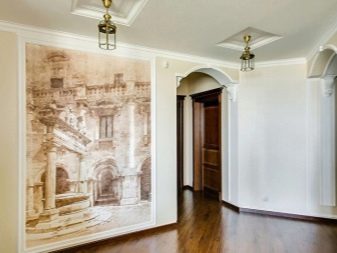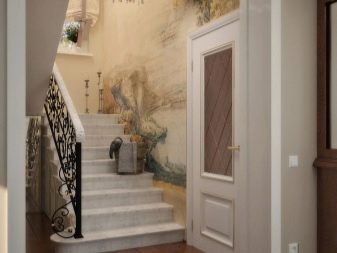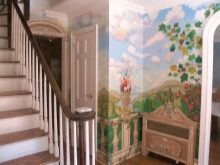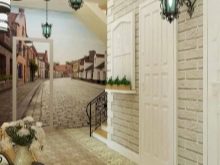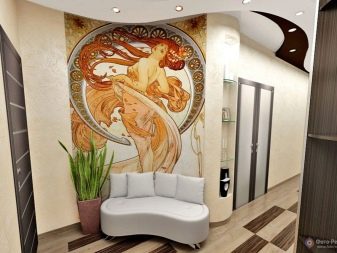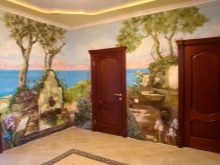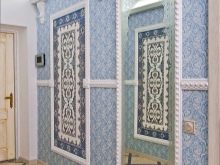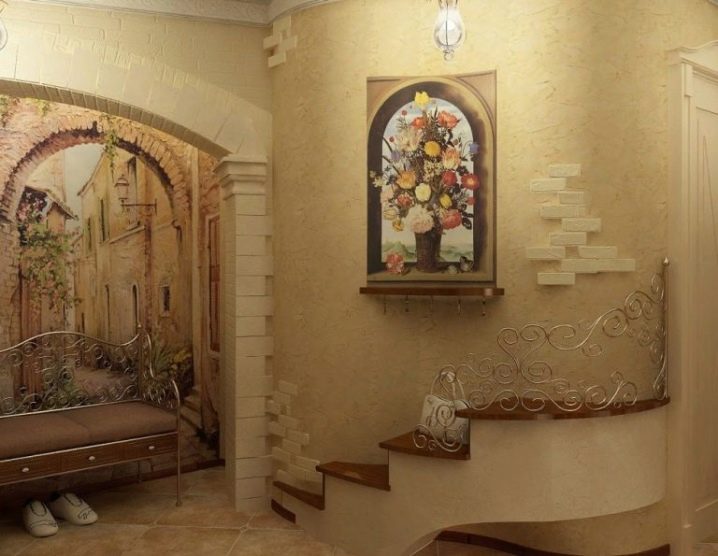Frescoes in the interior of the hallway
In modern interiors, fresco is considered one of the most popular decoration techniques. This is how the ancient Greeks and Renaissance artists painted houses. Images like this are an exquisite decor that will decorate the room and create a special mood in the hallway.
Advantages and disadvantages
A fresco is an artistic painting done on wet or dry plaster. In modern times, this is considered any image on the wall, made with paints or an airbrush. It can be a plot on canvas, as well as made by a digital printer, there are imitations on a self-adhesive base and on a non-woven fabric.
When choosing frescoes for the interior of the hallway, one must take into account the advantages and disadvantages of such a decor.
Pros:
- it is an economically affordable design;
- gives the space a scale and the effect of the disappearance of a wall or part of it;
- fits into a wide variety of designs;
- visually expands the space;
- divides into zones;
- can be placed anywhere (on the wall, on the ceiling);
- suitable for a city apartment and a country house
- authentic pieces are very durable.
Minuses:
- only a professional will make a real painting;
- surfaces must be leveled before application;
- painting itself will not hide the imperfections of surfaces;
- large formats are only suitable for large areas;
- you need to choose the right theme, for example, futuristic and space drawings are suitable for a modern style;
- demanding on temperature: they do not tolerate heat and cold;
- not suitable for rooms with high humidity, contact with water is also contraindicated if there is no special protective layer.
Species overview
The frescoes differ in their technique of execution.
- A traditional fresco is made on elastic plaster. So they painted in the days of Leonardo da Vinci. A wet layer is applied to the wall, and painting is done on top. The base dries quickly and becomes one with the paint. The image is particularly dull and will last for many years.
- Painting on canvas - a special composition is applied to the fabric, and a drawing is applied on top. A professional can create an authentic work of art. This option is convenient to purchase in a store on a roll or on a stretcher. Products on canvas are not moisture resistant, they are not washed, for a long service life they must be covered with wax.
- On non-woven fabric - this is an economical option suitable for images of different areas. Looks like canvas prints, but at a significantly lower price. The peculiarity of these sets is that they are glued, assembled from separate canvases.
- The image on the self-adhesive canvas resembles embossed wallpaper. Instead of lime, the wallpaper is digitally printed with a paste containing river sand. The glued sheet looks perfect only on a very flat surface.
- A drawing on a rigid base has significant weight and small dimensions. Plaster is applied to wood or ceramic base, rarely plastic. Acrylic paints are usually used. They are mounted like panels or paintings, sometimes glued. Often they are processed along the edges with chips and irregularities.
- Craquelure - this technology uses decorative plaster with the addition of marble chips. A significantly aged painting with cracks of any size and depth is obtained. Can be used for non-woven sheets and canvas.
Pictures vary in style. The picture on the wall is matched to the interior, emphasizes and organizes it.
- In the classics choose ceiling and wall varieties on canvas or plaster, often aged, with or without frames, with flowers, still lifes or landscapes.
- For modern trends - hi-tech or loft - choose abstractions using letters, numbers or architectural elements, street fragments, geometric shapes.
- Provence - these are canvases depicting the countryside: meadows, meadows, gardens and village streets.
- Modern - the choice of aesthetes. Often these are works of famous artists: paintings, ornaments and frescoes, popular at the beginning of the 20th century.
- Frescoes in minimalism - these are delicate airy drawings of leaves, trees, frosty patterns or landscapes, which sometimes appear as if through fogged glass.
For the hallway, according to the plot, landscapes, city streets are more often chosen - such compositions make a small room visually more spacious. Even a narrow wall can be decorated with a view of the sea or a road running away into the distance.
It is necessary to choose the optimal size for the canvas: a very large one will overload the interior, and a small one will be lost against the general background.
For a spacious hall, larger-scale scenes with a waterfall, forest or flowers are suitable. You can also choose figures of people against the background of nature or streets, as well as single trees, animals, architectural ensembles.
You should be very careful when choosing abstract subjects for a small and narrow room, as a rule, they do not create a sense of perspective and depth. In a huge area, such pictures will help to hide flaws, they still look advantageous in large light interiors.
Ornaments are a great choice for any size entryway. A wall or niche designed in this way is able to fill a large area, and several medium-sized canvases with bright ornaments in the frames will increase the visually narrow corridor.
Beautiful examples
- Often, frescoes are placed in a niche in the form of an arch with pilasters (protrusions that imitate columns). The landscape behind the pillars will appear very realistic if the lights are placed correctly.
- The image of streets and flowers is the most popular subject for a hallway in a classic style.
- The aesthetic painting creates the illusion of a sliding wall into a quiet garden. Soft flowing lines are combined with pastel colors and general interior decoration.
- A fresco depicting a window is a stylish and unexpected solution. The entrance area looks more spacious, the perspective is guessed behind the window sashes, and the greenery on the windowsill gives the impression of being real.
- The original idea is to apply a marine theme in a modern style. The artfully aged surface is perfectly matched by the rough and simple design.


